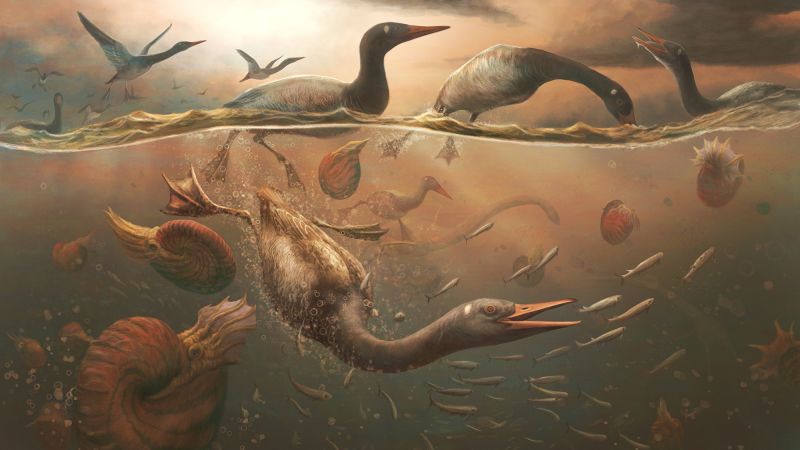A remarkable discovery in Antarctic paleontology has unearthed a nearly complete skull fossil that belongs to the oldest known modern bird. This bird, reminiscent in size to contemporary mallard ducks, has been identified as *Vegavis iaai*. A study highlighting its significance was recently published in the prestigious journal *Nature*. Notably, this species lived around 68 million years ago, during the close of the Cretaceous period, an era that witnessed the reign of the mighty Tyrannosaurus rex and the subsequent mass extinction triggered by a colossal asteroid impact.
The fossil of *Vegavis* offers a tantalizing glimpse into the avian world of the past, revealing a creature that shared ecological similarities with today’s aquatic birds, such as loons. Christopher Torres, an assistant professor of biology at the University of the Pacific and the study’s lead author, provides insight into its lifestyle. He describes how *Vegavis* was a foot-propelled pursuit diver, adept at swimming underwater in pursuit of fish. The fossilized skull indicated the presence of jaw musculature specialized for snapping its mouth shut during underwater hunting, a behavior akin to that observed in modern loons and grebes.
Despite initial skepticism regarding *Vegavis*’ classification as a modern bird, particularly when it was first described two decades ago, recent analyses have solidified its status within the crown bird group. Prior to this study, most fossils of modern birds unearthed hailed from a 66-million-year timeline, which postdated the catastrophic events that marked the extinction of the dinosaurs. Researchers previously held the assumption that modern bird species began to flourish after the mass extinction, further complicating the narrative surrounding *Vegavis*.
The fossil in question was meticulously collected during the 2011 Antarctic Peninsula Paleontology Project expedition. It was encased in rock, dating back approximately 68.4 to 69.2 million years, showcasing characteristics consistent with modern birds—most notably, its toothless beak. Study coauthor Patrick O’Connor, a professor of anatomical sciences at Ohio University, remarked on the particular importance of skull structures that facilitate the identification of modern birds’ defining characteristics.
According to Juan Benito Moreno, an expert on fossil birds at the University of Cambridge, this new fossil represents a crucial piece of evidence in paleontological discussions regarding *Vegavis*’ validity as a modern bird. Moreno noted that the morphology exhibited in the newly discovered skull is specialized for diving and fish-eating, surprising even seasoned specialists in the field. The computer tomography scans of the fossil revealed a brain shape characteristic of modern birds, thus further confirming its classification.
While *Vegavis* exhibits similarities to present-day waterfowl, it also possesses unique features. For instance, the skull hints at a slender, pointed beak reinforced by strong jaw muscles, a characteristic aligning more closely with diving birds than other waterfowl species. This duality highlights the complexity of avian evolution and opens up fascinating discussions about environmental adaptations through time.
During the Cretaceous period, Antarctica itself was vastly different from its present-day icy terrain; it was filled with forests and characterized by a temperate climate. The locality from which *Vegavis* was recovered suggests that it thrived in a nearshore marine environment, engaging in pursuit diving amidst a lush ecosystem.
The study of this ancient bird does not end with its classification. Torres, who previously worked on the research as a postdoctoral fellow, expresses an interest in exploring the fate of survivors after major extinction events, like that which wiped out the dinosaurs. Questions surrounding what determined survivorship and how species adapted post-extinction encapsulate ongoing endeavors in paleobiology, presenting a compelling narrative about the resilience and evolution of life on Earth following catastrophic environmental shifts.
In conclusion, the discovery of *Vegavis iaai* is not just a scientific find; it serves as a vital piece in understanding the evolutionary journey of birds and the ongoing legacy of species that survived one of Earth’s most significant mass extinctions. The continued study of such fossils not only enriches our knowledge of prehistoric life but also illuminates the intricacies of adaptation and survival in ever-changing environments.



